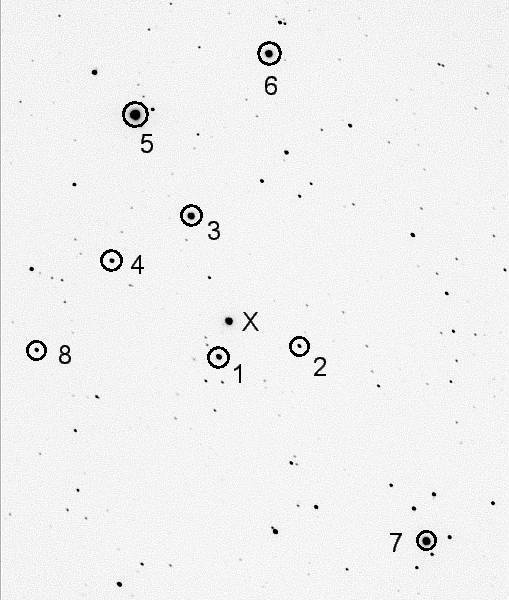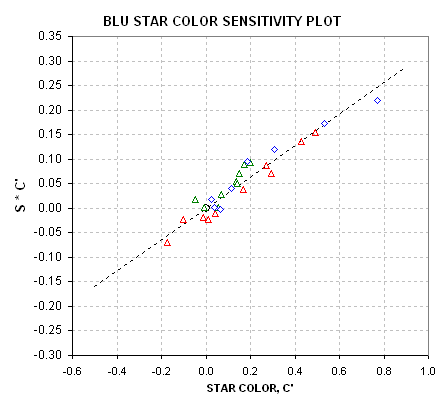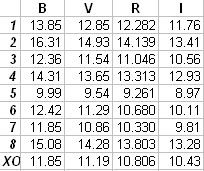
XO-1 is the sun-like star in the transiting exoplanet system in the constellation Corona Borealis, at RA = 16:02:11.6, Dec = +28:10:11. In the following image 9 stars are identified whose magnitudes have been measured with filters for the four bands B, V, Rc and Ic.

Figure 1. Finder chart for XO-1 (to left of X symbol) and
8 nearby candidate reference stars. FOV = 16 x 21 'arc, north up, east
left. Faintest stars in this rendition have V ~ 18.0. [Celestron
CGE-1400, 14-inch SCT, focal reducer, AO-7 image stabilizer, SBIG CFW8,
SBIG ST-8XE CCD; four 60-second exposures, 2006.02.27, Hereford, AZ]
Magnitudes for the 9 stars identified in this image
were determined from two all-sky photometry observing sessions, on
2006.02.25 and 2006.03.14. On each date 4-filter observations of the
XO-1 star field and two Landolt star fields (at RA/Dec
04:52:30/+00:03.0 and 12:42:22/-00:33.5) were conducted at times when
air mass was approximately the same. On the first date 28 Landolt stars
were used to establish "simplified magnitude equation" constants for my
telescope system, and on the second date 22 of these same stars were
used. The "simple magnitude equation" with constants to be solved for
is illustrated for V-band with the following equation:
V = 19.887 - 2.5 * LOG ( S' / g ) - 0.12 * m -0.05 * C'
where,
the three parameters to be solved-for using Landolt stars are shown as
bold and blue.
19.887 is a zero shift
constant (different for each filter, usually stable on month
timescales),
S' is star flux using a large aperture [counts],
g = exposure time [seconds],
0.12 is zenith extinction
constant [magnitudes per air mass], (different for each filter and
often different for each date),
m is air mass,
-0.05 is a star color
sensititivty constant to be solved for (different for each filter,
stable over time), and
C' = "linearized star color" defined as C' = C + 1.3 * C4, where C = 0.57 * (B-V) - 0.30 (for typical stars C' = C ~ zero).
A derivation and fuller description of "simple
magnitude equations," SME, (including an additional term for "air mass
times star color") is given at the web page SME_AllSkyPhotometry.
When observations of the target star field and
Landolt star fields are at the same air mass it is not necessary to
solve for the extinction constant. If there's a large separation in
observing times for the two star fields then temporal trends of
extinction can be important. For the calibrations described here the
two star field observations were closely spaced in time.
As an aside, the 2006.02.25 all-sky calibration of
SME constants were used to determine a photometric sequence for
GRB060218. I noted an approximate 0.25 magnitude discrepancy with SDSS
magnitudes for 5 stars for all 4 bands. The audacity of an amateur to
question SDSS photometry was noted (Arne) so I kept quiet and
merely described my results on a web page GRB060218. About a month later
(2006.03.20) Malcolm Hicken announced (on behalf of the CfA's
Supernova Group) via GCN 4898
that all-sky measurements taken at Mount
Hopkins showed that the SDSS magnitudes for stars in this region are
too bright by ~0.27 magnitude at V-band, and are too bright by similar
amounts at other bands. Their web page referred to stars with my finder
chart designation numbers, and they stated that their magnitudfes were
in agreement with mine. Additional information on this announcement can
be found at GCN 4898 Supporting Info. Amateurs don't get no respect! End of aside.
A sense of the quality of how well the SME solutions
fit the star flux measurements can be conveyed by describing RMS
residuals from the fitted equations. On the first calibration date the
Landolt stars exhibited RMS differences from the SME solution of
0.0199, 0.031, 0.026 and 0.036 magnitude for B, V, Rc and Ic (N = 29,
35, 18 and 14). On the second date the RMS residuals were 0.018, 0.012,
0.008 and 0.026 magnitude for B, V, Rc and Ic (N = 36, 20, 6 and 14).
The following graph illustrates the consistent correlation of a
parameter related to "star color sensitivity" versus star color for
B-band.

Figure 2. B-band star magnitude parameter
versus known star color for 36 Landolt stars, 2006.03.14 observations.
The slope of the fitted line is the "star color sensitivity" constant
for B-band.
The all-sky Rc magnitudes for the XO-1 stars derived on two dates
differed by only 0.003 magntude. The population SE for the differences
(8 stars) was 0.005 magnitude. The following figure is a weighted-average solution for star magnitudes for the XO-1 star field.

The estimated SE accuracy for these stars is:
B SE = 0.04 magnitude
V SE = 0.03 "
Rc SE = 0.020 "
Ic SE = 0.03 "
____________________________________________________________________
This site opened: May 16, 2006 . Last Update: May 18, 2006